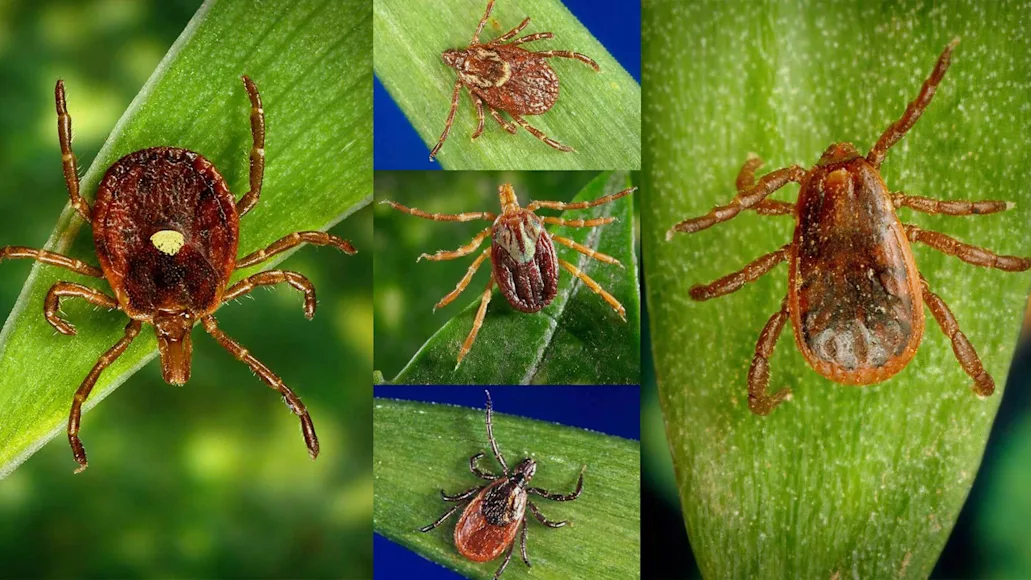Ticks—all species and types of ticks—are the worst. But good luck avoiding them—especially if you enjoy spending time in the outdoors. We are in the midst of one of the worst, and longest, tick seasons in recent memory, partly due to a warmer spring and longer summer. According to the Mayo Clinic, tick-borne illnesses
are becoming an increasing problem in the U.S. Between 2014 and 2018, more than 200,000 cases were reported.
Which is why we put together this comprehensive field guide about ticks. This guide delves into the diverse world of ticks, shedding light on their physical characteristics, geographical range, the pathogens they carry, and essential preventive measures. By the end of this field guide, you will possess the knowledge needed to identify different types of ticks, comprehend their range and associated diseases, and implement effective preventive measures.
How Many Types of Ticks Are There?
According to LymeDisease.org
, there are two “families” of ticks found in the United States: soft ticks (Argasidae) and hard ticks (Ixodidae). There are hundreds of type of ticks in the hard and soft families, but only a handful are known to bite and spread diseases. This story focuses on the most common species of ticks that spread tick-borne illnesses. By becoming familiar with these species, you can make informed decisions to protect yourself and your loved ones (including your pets) from tick-borne diseases.
Table of Contents
Black-Legged Tick (aka Deer Tick)
American Dog Tick
Lone Star Tick
Brown Dog Tick
Gulf Coast Tick
How to Prevent Tick Bites
FAQs
Final Thoughts
Types of Ticks
Black-Legged Tick (Ixodes scapularis)

An adult female black-legged tick. CDC
Overview: The black-legged tick, also known as the deer tick, is small and dark-colored. Females have a reddish-orange abdomen.
Field Notes
Home Range: Found primarily in the northeastern and midwestern regions of the United States and southeastern Canada.
Activity Patterns: Active from spring to fall, with peak activity during the warmer months.
Tick-Borne Diseases: Black-legged ticks are known for transmitting Lyme disease, anaplasmosis, and babesiosis.
American Dog Tick (Dermacentor variabilis)
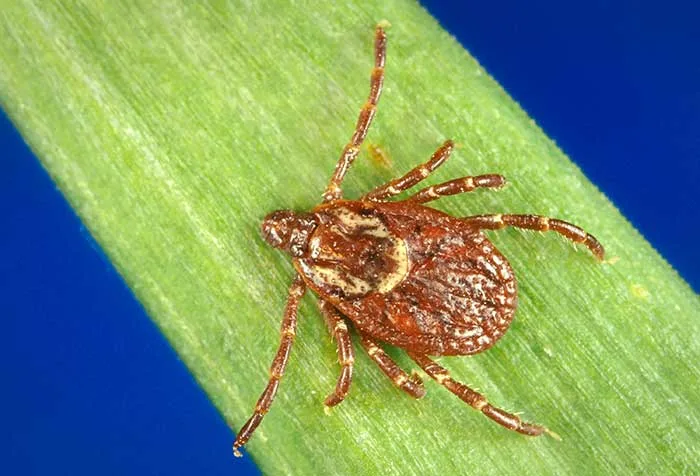
An adult female American dog tick. CDC
Overview: The American dog tick is a larger type of tick. Females have a distinctive white- or cream-colored scutum, which is the hard covering around a tick’s head.
Field Notes
Home Range: American dog ticks are found throughout most of the United States, particularly in wooded and grassy areas.
Activity Patterns: Active from early spring to late fall, with peak activity during the summer months.
Tick-Borne Diseases: American dog ticks can transmit diseases like Rocky Mountain spotted fever and tularemia.
Lone Star Tick (Amblyomma americanum)
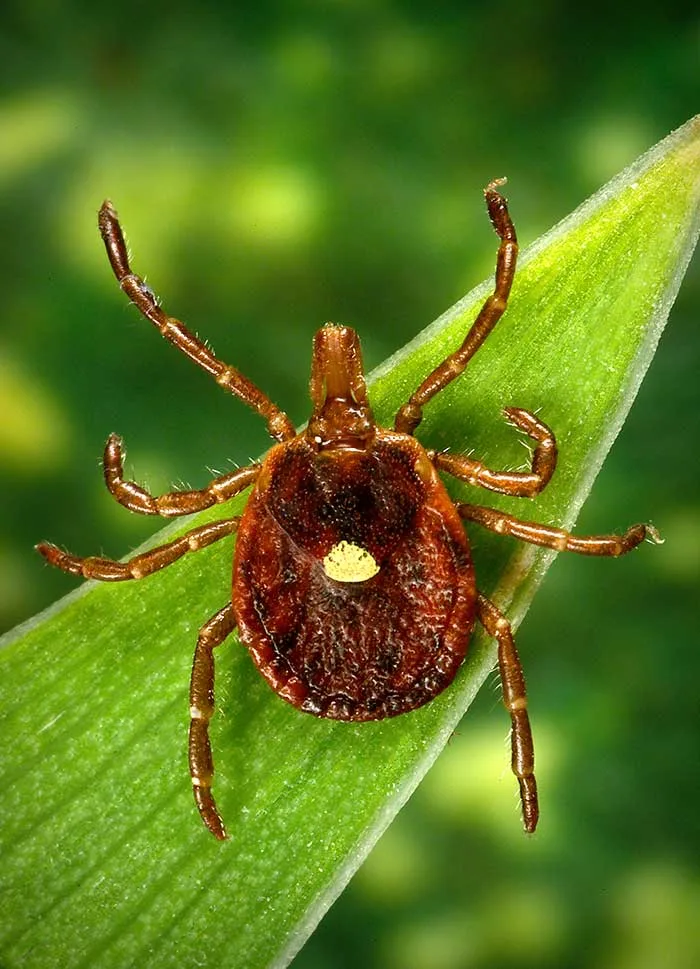
An adult female lone star tick. CDC
Overview: The lone star tick is medium-size type of tick. It has a distinct white or silver spot on the back of the females.
Field Notes
Home Range: The lone star tick is found in the southeastern and eastern regions of the United States.
Activity Patterns: Active from spring to fall, with peak activity during the summer.
Tick-Borne Diseases: Lone star ticks can transmit diseases such as ehrlichiosis, tularemia, and southern tick-associated rash illness (STARI).
Brown Dog Tick (Rhipicephalus sanguineus)
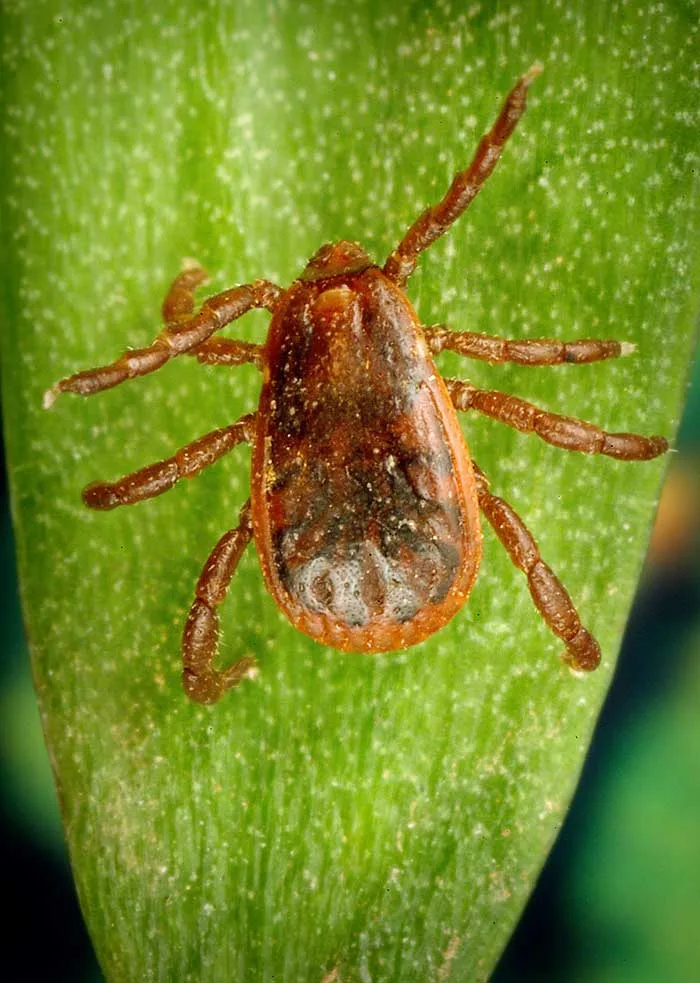
An adult male brown dog tick. CDC
Overview: The brown dog tick is reddish-brown in color and has a slender body.
Field Notes
Home Range: Brown dog ticks are distributed across North America.
Activity Patterns: Active yearly, with no specific seasonal preference.
****Tick-Borne Diseases: Brown dog ticks can transmit diseases, such as canine ehrlichiosis and babesiosis. They are primarily associated with infestations in dogs.
Gulf Coast Tick (Amblyomma maculatum)

An adult female Gulf Coast tick. CDC
Overview: The Gulf Coast tick is brown and has white or yellow spots on the scutum.
Field Notes
Home Range: The Gulf Coast tick is a type of tick that is found in the southern United States and the Gulf Coast.
Activity Patterns: Active from spring to fall, with peak activity during the summer.
Tick-Borne Diseases: Gulf Coast ticks can transmit rickettsiosis and ehrlichiosis.
These are just a few examples of tick species commonly found in North America. It’s important to note that tick distribution can vary within regions, and new species or geographic expansions may occur over time. Understanding the different types of ticks in your area can help you take appropriate preventive measures to avoid tick bites and reduce the risk of tick-borne diseases. Let’s dig into a few of these preventative measures.
What Other Types of Ticks Look Like
Rocky Mountain Wood Tick (Dermacentor andersoni)
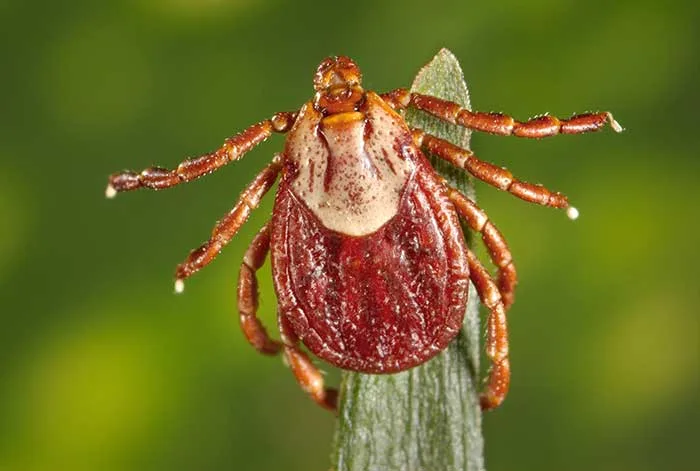
The Rocky Mountain Wood tick looks like the American dog tick and are found predominantly in shrub lands, wooded areas, open grasslands, and trails, mainly at subalpine elevations in the Mountain and northwest Pacific regions. CDC
Groundhog Tick (Ixodes cookei)

According to the Mayo Clinic, the groundhog tick, also known as a woodchuck tick, is mainly located in the eastern half of the U.S. It rarely bites humans and is responsible for spreading Powassan virus disease. CDC
Western Blacklegged Tick (Ixodes pacificus)
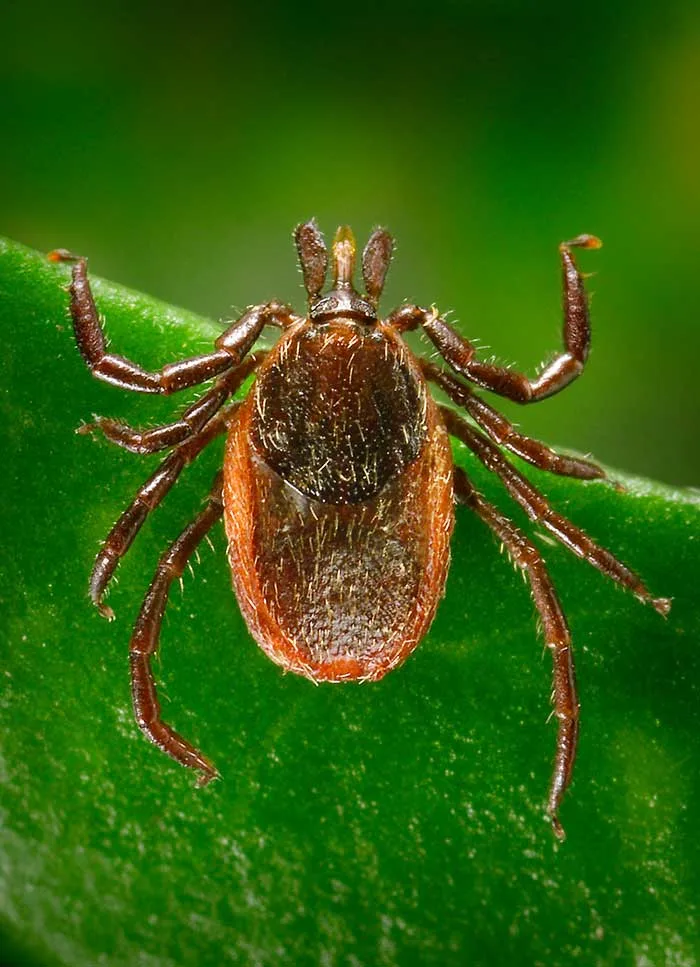
According to the University of Rhode Island
, the western blacklegged tick is widely distributed in Pacific Coast states and British Columbia in Canada. It is the principal vector of Lyme disease bacteria and several other disease-causing germs. It is especially abundant along northern coastal habitats and the western Sierra Nevada range. CDC
Asian Longhorned Tick (Haemaphysalis longicornis)
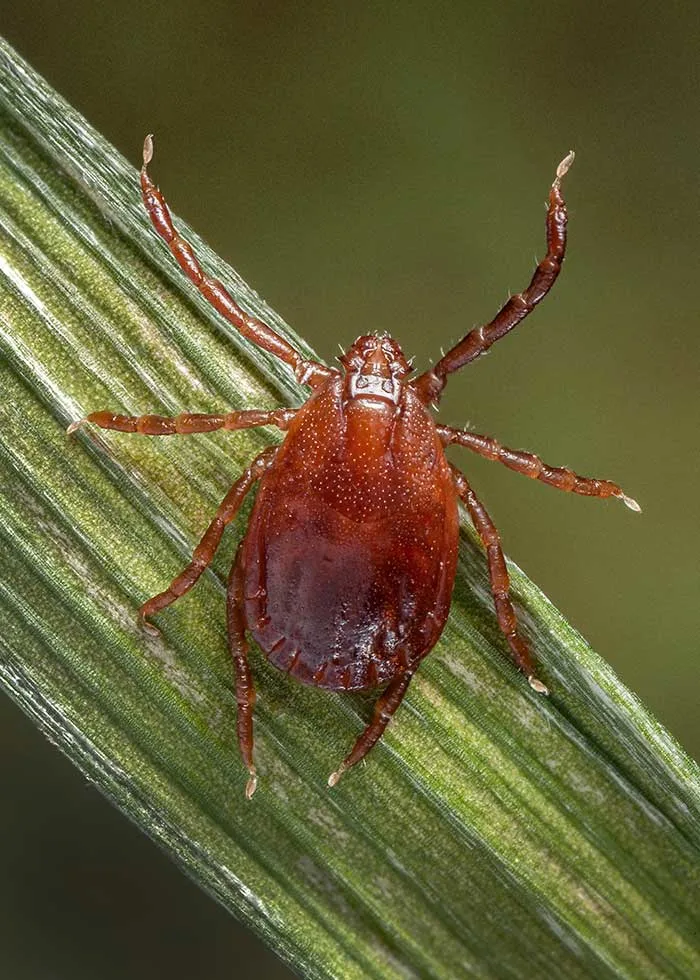
According to the CDC, this type of tick was not normally found in the Western Hemisphere—until 2017, when they were reported for the first time in the United States. CDC
How to Prevent Tick Bites
The types of ticks profiled above are known vectors for various diseases, making tick-bite prevention critical to safeguarding your health. By following these essential measures, you can learn how to prevent tick bites
and the potential transmission of tick-borne illnesses.
Implementing these preventive measures can significantly reduce the risk of tick bites and the potential transmission of tick-borne diseases. Stay vigilant, educate yourself about the types of ticks in your region, and promote a tick-safe environment for yourself, your family, and your pets. Remember, early detection and prompt removal of ticks are crucial in minimizing the risk of tick-borne illnesses.
1) Keep Activity and Moisture to a Minimum
Ticks are susceptible to drying out and must absorb water from their environment to remain hydrated. They are also attracted to warm-blooded animals like you, me, and our pets. Therefore, avoid damp and moist areas and increase your tick checks when you are damp and warm.
2) Wear Protective Clothing
Dress appropriately when venturing into areas like forests or grassy fields that are prone to the types of ticks described above. Wear long sleeves, long pants, and tuck your pants into your socks or boots. This creates a barrier that makes it harder for ticks to reach your skin. You can also use heavy-duty duct tape around your ankles to secure the pants to your boots and significantly decrease access areas to your body. An alternative is to wear shorts and sandals. This allows you to feel the ticks more readily and remove them quickly. If I am in a tick-prone area for a long time and don’t have much time to stop and undue my pants and socks for a check, I will tape up. If I go for a short time and can stop regularly, I sometimes use the alternative method.
3) Use Insect Repellents
Apply EPA-registered insect repellents to exposed skin and clothing. Look for products containing DEET, picaridin, or permethrin. Follow the instructions on the label for safe and effective use. Remember to reapply as directed, especially if you sweat or spend extended periods outdoors. My strategy is to utilize picaridin lotion on my skin, DEET on clothing, and use permethrin on clothing. Please remember that picaridin and deet are repellants and will serve to repel the critters but not injure them. This means the ticks will often just keep looking for another avenue of entry. Apply or spray them whenever you go afield. Permethrin on the other hand is an insecticide. It serves to injure and sometimes kill most ticks. It works best when it is applied to clothing 24 hours in advance of when you may need it. Spraying it on as you go afield is not as effective and is one of the most mis-used methods in tick prevention. Check the product label as most products with permethrin will last several washings when they are allowed to soak and dry on the clothing.
4) Conduct Regular Tick Checks
Perform thorough tick checks on yourself, family members, and pets after spending time in tick-prone areas. Examine all body areas, paying close attention to the scalp, hairline, underarms, groin, and behind the knees. Any area that might hold moisture and heat as discussed earlier. These checks should be done at a minimum of every 24 hours. If you have trouble seeing some parts of your body for an adequate check, use a mirror from a compass or take a video with your cell phone in those hard-to-see areas (just ensure you delete the video when completed). Promptly remove any attached ticks using fine-tipped tweezers, grasping the tick close to the skin, and pulling it straight out.
5) Modify Landscapes
Create tick-safe environments around your home. Keep lawns well-maintained, mow regularly, and remove leaf litter or brush piles that may attract ticks. Consider creating a barrier of gravel or wood chips between your lawn and wooded areas to reduce tick migration.
6) Create Tick-Repellent Zones
Consider incorporating plants that naturally repel ticks if you have a yard or garden. Examples include rosemary, lavender, and marigolds. Additionally, you can install physical barriers, such as deer fences or tick tubes, to deter ticks from entering your property. A pest control operator can help you determine the best course of action near your wooded homes.
7) How to Protect Pets from Types of Ticks
Ticks can also target our furry companions. Consult your veterinarian about the best flea and tick prevention for dogs
, such as tick collars, spot-on treatments, or oral medications. Regularly check your pets for ticks, and promptly remove any you find. Some pets, like my dog Tracker, can develop seizures from some oral tick meds so don’t take this recommendation lightly. Consult your veterinarian about this.
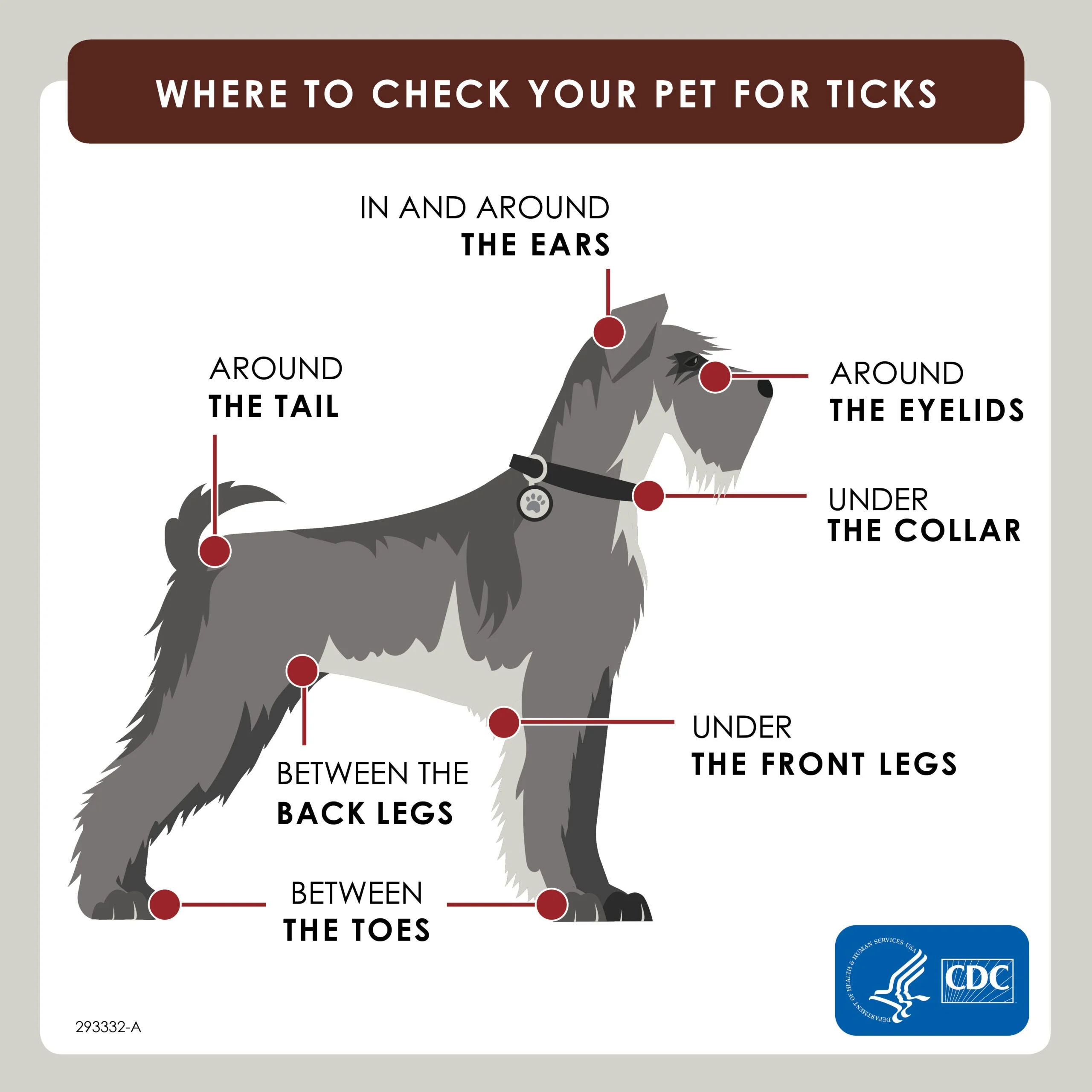
This illustration shows were to check your dog for ticks. CDC
8) Shower and Wash Clothes
After spending time outdoors, shower as soon as possible. This can help wash off unattached ticks and allow you to perform a more thorough tick check. Toss your clothes into a hot dryer for at least 10 minutes to kill hidden ticks.
FAQs
Q: What are ticks?
Ticks are tiny arachnids that can pose significant health risks to humans and animals. With the ability to transmit various diseases, including Lyme disease
, Rocky Mountain spotted fever, and anaplasmosis, understanding these resilient parasites is crucial for safeguarding our well-being.
Q: What are 4 diseases caused by ticks?
There are numerous tick-borne diseases. Among the most common are lyme disease, anaplasmosis, babesiosis, and Rocky Mountain spotted fever.
Q: What time of day are ticks most active
Ticks are most active during warmer months, typically from spring to fall. Stay informed about tick activity in your area and be extra vigilant during peak seasons. However, it’s important to note that ticks can be active year-round in specific regions and microclimates.

Shower as soon as you get home after spending time outdoors during tick season to help wash off unattached ticks. Craig Caudill
Final Thoughts
This field guide you just read about the types of ticks offered detailed overviews of each species of tick, including their physical attributes and identifying features. Additionally, we discussed their preferred habitats and geographic range, providing insights into the regions where these ticks are most prevalent.
Furthermore, we will dove into the diseases transmitted by each tick species, outlining their specific pathogens and the potential health risks involved. By understanding the disease transmission patterns, you can better recognize the symptoms and seek appropriate medical attention when necessary.
Please consider all this information a precursor to medical advice from a qualified physician, much like first aid. Diseases from tick bites can be tough to diagnose with just a visual inspection. It goes beyond the “bull’s-eye” rash commonly shared as the go-to tick bite identifier. I have been diagnosed with Lyme disease and Rocky Mountain spotted fever. Neither gave me an early indication of a bull’s-eye rash or similar. In both cases, I never realized I had a tick on me until I was already experiencing health issues. Both were years ago, and I have been studying and asking experts about ticks ever since. This article was a compilation of that research.
Lastly, preventive measures are crucial in mitigating the risk of tick bites and subsequent infections. This guide will equip you with practical strategies for personal protection, such as using repellents, wearing protective clothing, and performing regular tick checks. Additionally, we highlighted environmental control methods to minimize tick habitats in residential areas.

